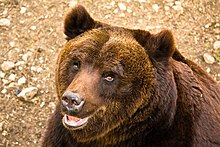
Back Apennin qonur ayısı Azerbaijani মারসিকান বাদামি ভাল্লুক Bengali/Bangla Os bru dels Apenins Catalan Marsischer Braunbär German Ursus arctos marsicanus Spanish خرس قهوهای مارسیکایی Persian Ursus arctos marsicanus French דוב חום מרסיקן HE Beruang cokelat marsica ID Ursus arctos marsicanus Italian
| Marsican brown bear | |
|---|---|

| |
| Scientific classification | |
| Domain: | Eukaryota |
| Kingdom: | Animalia |
| Phylum: | Chordata |
| Class: | Mammalia |
| Order: | Carnivora |
| Family: | Ursidae |
| Genus: | Ursus |
| Species: | |
| Subspecies: | U. a. marsicanus / arctos
|
| Trinomial name | |
| Ursus arctos marsicanus / arctos Altobello, 1921
| |

The Marsican brown bear (Ursus arctos arctos,[3] formerly Ursus arctos marsicanus), also known as the Apennine brown bear, and orso bruno marsicano in Italian, is a critically endangered[4] population of the Eurasian brown bear, with a range restricted to the Parco Nazionale d'Abruzzo, Lazio e Molise, and the surrounding region in Italy. The Marsican brown bear differs slightly from other brown bears in its appearance and hibernation techniques. The bear's popular name is derived from Marsica, a historic area of the modern-day region of Abruzzo where the bear has long had a significant presence.
With their existence dwindling, the Italian government has recently begun to stress their conservation. The park has become a sanctuary dedicated to animals such as the Marsican brown bear, with hopes of rekindling the large, yet isolative bears' once-thriving existence. Debate exists as to whether it should be considered a subspecies or a taxon of its own.[5]
- ^ "Brown Bear (Ursus arctos) Isolated Subpopulations". IUCN. Retrieved 29 August 2022.
- ^ "Endangered Species". awionline.org.
- ^ Wozencraft, W. C. (2005). "Ursus arctos". In Wilson, D. E.; Reeder, D. M. (eds.). Mammal Species of the World: A Taxonomic and Geographic Reference (3rd ed.). Johns Hopkins University Press. pp. 588–589. ISBN 978-0-8018-8221-0. OCLC 62265494.
- ^ Djuro Huber (Large Carnivore Initiative for Europe; Bear Specialist Group) (2006). "Ursus arctos". IUCN Red List of Threatened Species. 2006.
- ^ Loy, A.; P. Genov; M. Galfoc; M. G. Jacobonec; A. Vigna Tagliantic (2008), "Cranial morphometrics of the Apennine brown bear (Ursus arctos marsicanus) and preliminary notes on the relationships with other southern European populations", Italian Journal of Zoology, 75 (1): 67–75, doi:10.1080/11250000701689857
© MMXXIII Rich X Search. We shall prevail. All rights reserved. Rich X Search

